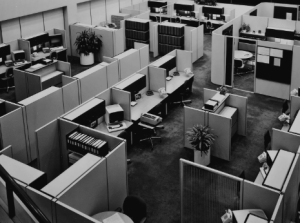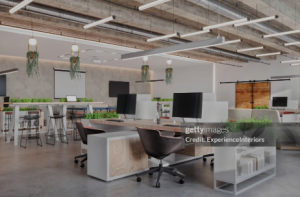This topic has been thrust into the forefront starting with tech companies and startups, it was pushed harder with Covid and demanded by millennials, and Gen X & Z. This is not a bad thing! Think about it, which herd of cows produce the most and best quality of milk?
 or
or 
That being illustrated, it should be no question as to which office produces the most and best work with ease of collaboration.
 or
or 
Wellbeing in this age of climate change, global warming, greenhouse gas, carbon neutrality, net zero, ESG is critical to the bottom line of every employer.
What does it include?
1. Indoor Air Quality (IAQ)
2. Indoor Environmental Quality (IEQ)
A. Biophilia
B. Lighting
C. Ergonomics
D. Sight Lines
E. Furnishings
3. Choice
A. Working Locations (Away from Office/Office)
B. Working Locations/Styles (Office)
C. Flexible Hours (Appointments/Drop Off and Pick up Children)
IAQ
Facility design today needs to include zonal HVAC so that with the installation of sensors we can create IAQ that is healthy and comfortable. More A/C near south facing windows, less in interior offices all based on the occupancy and other sensor determined factors such as Co2, humidity and body count. Doing this will create a dynamic, comfortable space, that helps employee wellbeing but not yet an inviting one.
IEQ
Biophilia is where IEQ comes into play. Sterile environments create sterile ideas, environments with natural elements such as light, plants, wood create a warm inviting environment with pleasing sight lines, much like the cows in the pasture vs the cows at the feeding trough.
Overhead lighting needs to create a comfortable ambiance without harshness, paired with task lighting we can create an environment where everyone has the light they need to comfortably accomplish their tasks. Full working level lighting overhead creates a bright glaring washed out scene that no one is comfortable with.
Ergonomic seating, workstations mean that we can sit comfortably and focus on our tasks without the strain in our shoulders, knees, neck from improperly designed workstations. This applies to areas that are gathering areas as well, ergonomic seating whether a couch, comfortable chair or an office chair promotes employee health and wellbeing.
Sightlines are created by installing low light level overhead lighting, even better is lights that ‘harvest’ incoming outdoor light and adjust their output to maintain the same level of ambient light in the space. Sightlines are enhanced by removal of tall cubicles that block sightlines. Adding art on the walls, and sound absorption panels hanging at key locations will provide visual variety. A variety of different hanging lights to designate different work areas creates great sight lines as do ‘wayfinding’ lights along walkways that are in the middle of a work area. All of this enhances the workspace design and health and wellness of the employees.
Furnishings will make or break an environment. Here we can take a step back from nature and have a little fun with a more modern approach that gives variety in sight, space and feel of the environment. Comfy overstuffed chairs with a more modern workspace aesthetic provides boundaries yet is inviting. This enhances the workplace environment and mental health and wellbeing of the employees and improves moral and efficiency.
Combining all these IEQ design elements invites employees to be in the office, and to stay focused, engaged and encourages collaboration. Those elements enhance our wellbeing.
CHOICE
This is the one that creates the biggest controversy! Should employees be required to be in the office a certain number of days? Full time? Can they get their work done out of the office? Should it be up to each department to determine these rules or guidelines? How do we get the most out of the real estate we are paying for? Should flexibility be given to allow for children, doctors’ appointments and the like?
I cannot answer those questions. But I can say this: Employees want because they need these things. They want to regain a work-life balance, and they will give their employer what is needed more readily if they are treated as responsible adults. They will come in the office as they need to meet with colleagues, to have one on ones, to enjoy the comradery IF the office is properly designed to provide the IAQ, IEQ and policy trusts them to make the right choices.
Intentionality in design choice means that we have created a flexible environment for all employees to make work location choices within the office, allowing for our individual neurodivergent needs to be met so we can be more productive, healthy, and choose to stay with this company.
CONCLUSION
Sick employees are inefficient, disagreeable, and uncooperative. Creating the right environment using all the elements above have a huge ROI in Employee health and wellbeing, Employee retention and hiring. We will be enabled to hire better employees and retain them which translates to huge savings. Insurance rates drop since employees are sick less often, fewer sick days are taken.
We have been talking about employee health and wellbeing, but following these guidelines means that we also now have improved the health and wellbeing of the organization. That is everyone’s goal.



